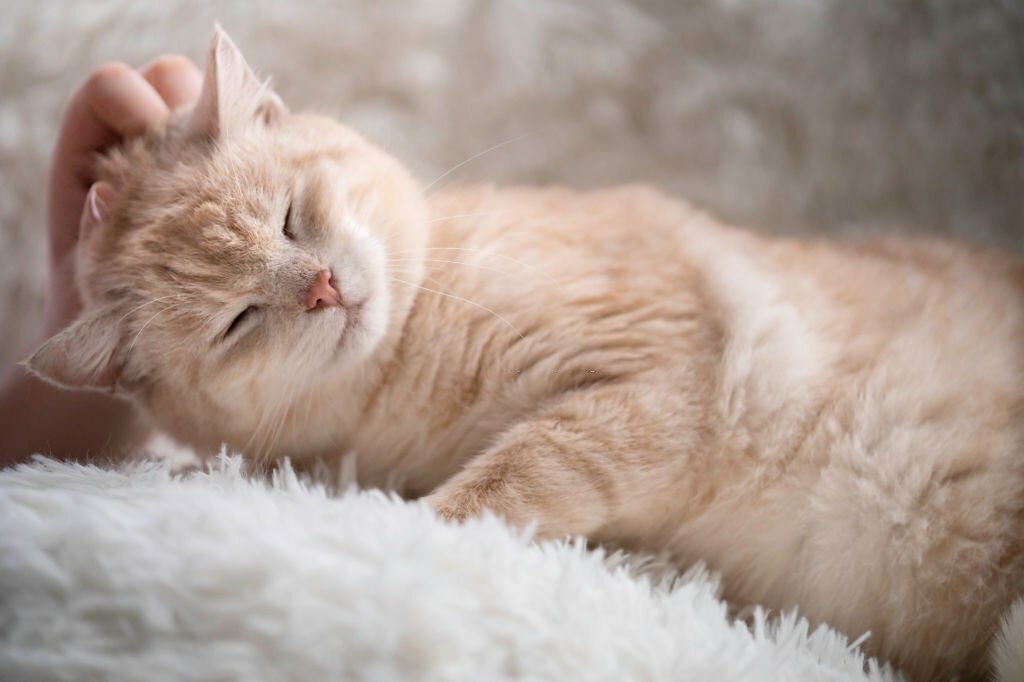Scientists Have Only Just Figured Out How Cats Purr
The type of sound an animal produces is usually linked to the size of its vocal folds. Vocal folds are two strips of smooth muscle tissue in the larynx, a hollow tube in the middle of the neck that air passes through to generate sounds.
Author:Buttskin FamilyReviewer:Caden SteelheartDec 01, 20236.3K Shares452.1K Views

The soothing sound of a cat's purr is a joy for any cat lover. However, understanding how these furry companions create this comforting sound has remained a mystery for a long time.
But now, a recent study might have finally cracked the code. It turns out that our domestic feline friends have special "pads" nestled within their vocal cords. These pads contain an extra layer of fatty tissue, enabling them to vibrate at low frequencies. Even more fascinating is that a cat's larynx, responsible for the purring, seems to work its magic without any signals from the brain.
In the past, explanations for purring were often more guesswork than science. Various theories were proposed but rarely put to the test. This new study, however, marks a significant step forward in unraveling the purring puzzle, as it provides concrete insights into this beloved feline phenomenon.
Vocal Fold Length And Animal Sounds
The type of sound an animal produces is usually linked to the size of its vocal folds. Vocal folds are two strips of smooth muscle tissue in the larynx, a hollow tube in the middle of the neck that air passes through to generate sounds.
Typically, larger animals have longer vocal folds, resulting in lower-frequency sounds. This phenomenon explains why domestic cats, despite their small size, have relatively short vocal folds for high-frequency sounds like meowing and screeching. However, according to Christian Herbst at the University of Vienna in Austria, it doesn't account for their enigmatic purring behavior, which they share with some wild counterparts like cheetahs and lynxes.
To untie this mystery, scientists have suggested that purring relies on muscle contractions in the larynx. Herbst and his colleagues decided to put this hypothesis to the test by conducting experiments involving eight domestic cats that had been euthanized due to illness.
Connective Tissue's Role And The Enigmatic Purpose Of Purring
The researchers made a fascinating discovery: when they passed air through the larynxes, they produced a purring sound without muscle contractions. Instead, the magic behind these sounds lay in the connective tissue nestled within the vocal folds.
This connective tissue had been previously identified in cats, but no one had connected it to the act of purring until now, according to Herbst. However, these findings don't entirely rule out that muscle contractions still enhance purring sounds in live cats.
As for why cats purr, that puzzle remains partly unsolved. Purring is often associated with contentment and an invitation for more interaction, but it's also been proposed as a soothing mechanism that aids in healing after injury. The full spectrum of reasons behind this unique feline behavior intrigues researchers.
A New Perspective On Mechanisms And Vocalization Frequencies
Understanding how domestic cats, which are relatively small animals averaging about 4.5 kilograms, manage to produce low-frequency purring sounds—typically between 20 and 30 hertz (Hz)—has long baffled researchers. Such low frequencies are usually associated with much larger creatures, like elephants, which boast considerably longer vocal cords. It's worth noting that while big cats like lions and tigers can deliver thunderous roars, domestic cats are limited to these enigmatic low-frequency purrs.
A similar mechanism is in mammal vocalizations, including other cat sounds like meowing and hissing. A signal from the brain prompts the vocal cords to come together, and the airflow through the larynx causes the lines to collide hundreds of times per second, producing sound.
This process, known as flow-induced self-sustained oscillation, is passive. Once the vocal cords start vibrating, they require no further neural input to keep producing sound.
However, in the 1970s, an alternative theory emerged. This "active muscle contraction hypothesis" theory suggests that domestic cats contract and relax their laryngeal muscles approximately 30 times per second to create purring sounds. This idea gained traction, supported by measurements of electrical activity in the laryngeal muscles of purring cats, and has since become a prevalent explanation for cat purring.
This groundbreaking study challenges conventional wisdom. Scientists conducted an unconventional experiment to investigate how cats produce those distinctive purring sounds. They removed the larynges from eight domestic cats, all of which had been humanely euthanized due to terminal illnesses, with the full consent of their owners.
The researchers gently pinched the vocal cords and passed warm, humid air through them. By isolating the larynx in this manner, they ensured that any sound produced would occur without the involvement of muscle contractions or input from the brain.
What they discovered was nothing short of astonishing. All eight larynges generated self-sustaining oscillations ranging from 25 to 30 Hz without active neural control, producing purring sounds. This revelation challenges the notion that purring requires dynamic muscle contractions.
The key to this phenomenon appears to be unusual masses of fibrous tissue nestled within the cats' vocal cords, often called "pads." While anatomists had noticed these masses before, their function remained a mystery. It's now plausible that these pads increase the density of the vocal cords, causing them to vibrate more slowly. This unique mechanism allows cats to produce low-frequency sounds despite their relatively small size, functioning similarly to the "vocal fry" effect sometimes found in human speech.
Debating The Mechanism Of Cat Purring
In light of this new evidence, the study suggests that purring, like meowing and hissing, is a passive process that unfolds automatically after the cat's brain initiates the purring signal. This explanation aligns more closely with our understanding of vocalizations in other vertebrates, according to Karen McComb, an expert in animal behavior and cognition at the University of Sussex, who wasn't involved in the research.
However, only some are entirely convinced. David Rice, a biomechanical engineer at Tulane University, suggests that the behavior of living cats' vocal cords might differ from those surgically removed for the study. He likens studying excised larynges to analyzing the sounds a wind instrument produces without its mouthpiece.
The Complexity Of Cat Purring
Christian Herbst, the study's lead author, speculates that purring likely involves a combination of neuronal control and self-sustaining oscillation. Yet, it remains challenging to definitively determine this, as cats typically only purr when they feel safe, comfortable, and content. This state would be disrupted if uncomfortable probes were inserted into their larynxes. The complete truth about cat purring may remain vague when a workaround for this problem is found.

Buttskin Family
Author
The Buttskins are a crazy author family who love writing, laughter, and eating an unhealthy amount of junk food. Mom Rockita started scribbling stories as soon as she could hold a pen, and Dad John didn't realize authoring children's books was a real job until after they were married.
Their kids have embraced storytelling at an early age. Little Lucy, age 5, dictates her colorful tales about dragons and princesses to her parents. Her 8-year old brother Jake collects scraps of paper to diagram his latest imaginary adventure involving ninjas and dinosaurs.

Caden Steelheart
Reviewer
Caden Steelheart, an enigmatic author, weaves tales that immerse readers in the depths of sin city's underbelly. With his words as a weapon, he crafts literary masterpieces that reflect the dark and dangerous spirit of the city. Caden's writing captures the gritty essence of sin city, delving into the intricacies of its characters and the moral complexities that define their existence.
Born amidst the shadows, Caden draws inspiration from the relentless chaos and unforgiving nature of the city. His words carry the weight of experience, creating a vivid and haunting portrayal of sin city's undercurrents. Through his stories, he explores the blurred lines between right and wrong, exploring themes of power, deception, and redemption.
Caden Steelheart's literary prowess has made him a name whispered in literary circles, captivating readers with his ability to immerse them in sin city's intricately woven tapestry. With each written word, he invites readers to journey into the darker realms of the human experience, offering them a glimpse into the secrets and sins that shape the city's inhabitants. Caden Steelheart, a master of capturing the essence of sin city through his writing, continues to captivate audiences with his haunting and evocative narratives.
Latest Articles
Popular Articles